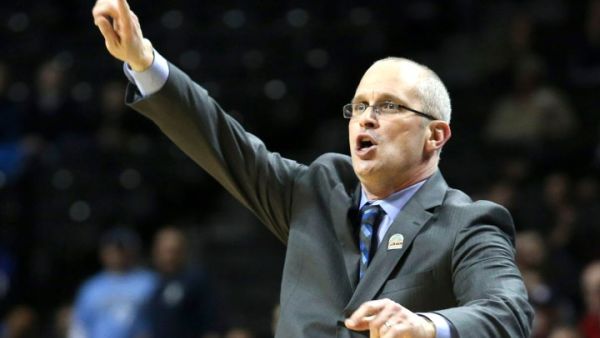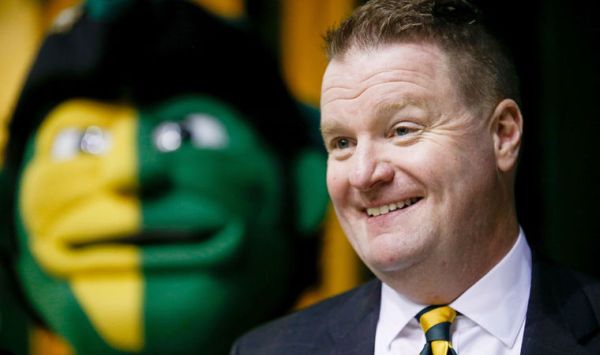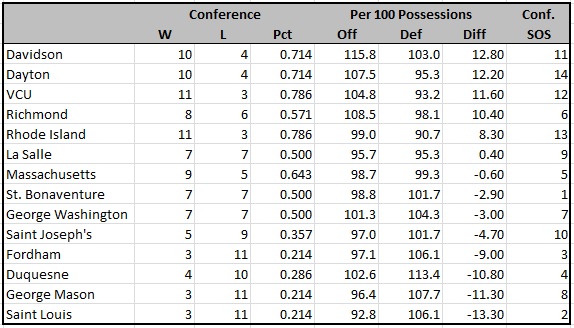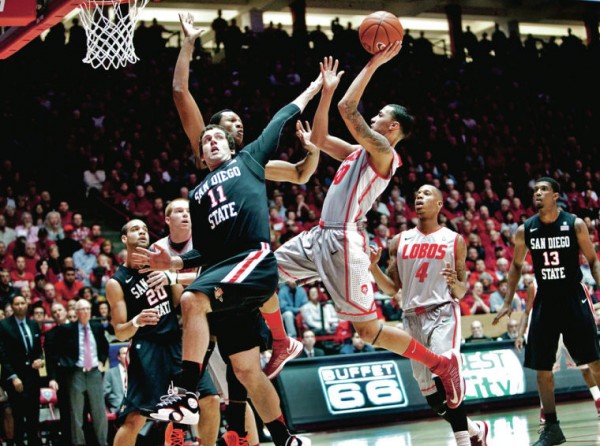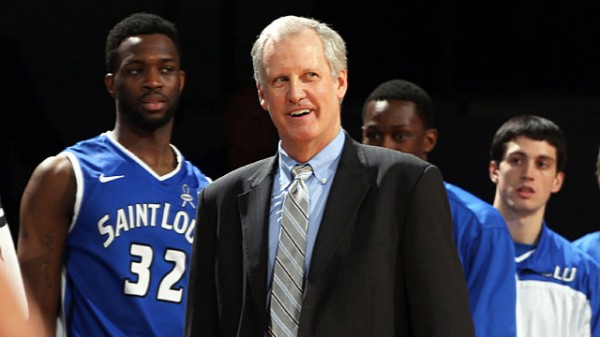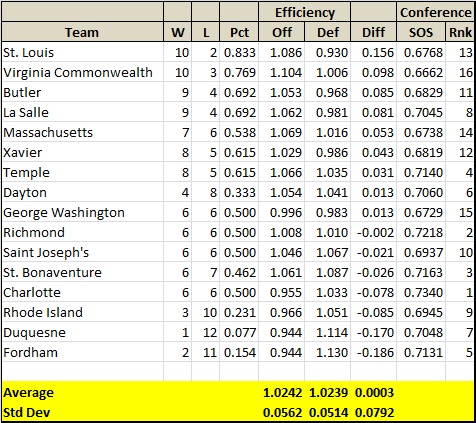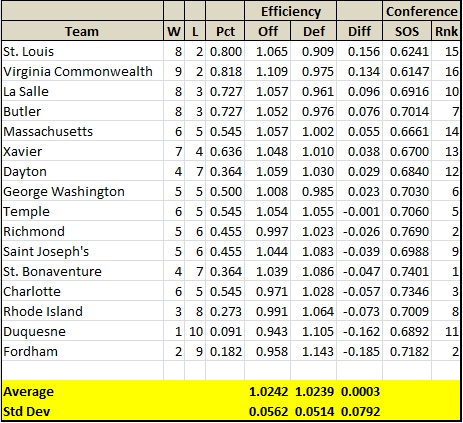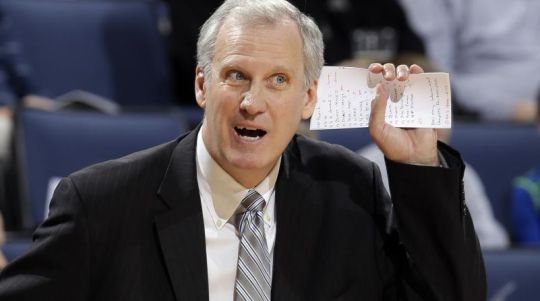Posted by CNguon on December 19th, 2012

Joe Dzuback is the RTC correspondent for the Atlantic 10 Conference. You can also find his musings online at Villanova by the Numbers or on Twitter @vtbnblog.
Looking Back
Conference Records: Previews in September and October offered rosy predictions on the number of teams that could/would qualify for the NCAA Tournament. If the previews were too exuberant, a poorly timed loss or two has brought that pendulum back in the opposite direction… with a vengeance. How is the conference really doing relative to last season? Compiling the games through December 17 of this and last season puts the progress in a different light.

The conference has won 65% of its games this season, a modest increase over its 62% winning percentage at this point last season. The conference has played games with teams from 29 of the 30 other conferences and independents in Division I, even if the mix has changed. Nearly 30% of the opponents have come from power conferences, about the same as last season (28%), although the winning percentage has declined (50% down to 41%). A-10 teams are dominating the other, non-power conference opponents, winning over 75% of games from both conference with a similar profile (Conference USA, the Colonial Athletic Association, the Missouri Valley Conference, the Western Athletic Conference, the Mountain West Conference and the West Coast Conference) and those with a lower profile.
A few quick observations:
- A-10 teams have a winning record (5-3) against the SEC and compliments of Butler’s upset over #1 Indiana last Saturday, a 5-3 record versus the Big Ten. Three of those SEC wins came against a now-struggling Alabama team.
- The A-10 has cleaned the CAA’s clock for the second year running, compiling a dominant (18-1) record versus the CAA that bested even last season’s impressive 11-3 record. Although Bernadette McGlade did successfully raid the CAA for Virginia Commonwealth University, the CAA still has a recent Final Four participant (George Mason) and a relatively deep conference. Losing records versus the West Coast Conference (0-2) and the Missouri Valley Conference (2-3) balances strong records versus the CAA and Conference USA (4-0). Conference teams have two more games versus the WCC.
Crossroads at the Crosstown? When they last met in the Crosstown Classic (nee’ “Shootout”), Xavier was 8-0 and hitting on all cylinders. Cincinnati was, on the strength of a 5-2 record that included a home loss to lowly Presbyterian, searching for the chemistry to ignite their season. The 23-point Xavier thrashing of Cincinnati that culminated in a bench-clearing brawl, however, threw each program on a very different path last season. Xavier finished the year with a so-so 15-13 run while Cincy compiled a 21-8 record and earned an NCAA bid that seemed all but impossible on December 11, 2011. The court will be neutral this time (a change negotiated to insure each school had 50% of the tickets, a measure to keep the crowd “balanced”), and Cincinnati appears to have the momentum, sporting a 9-0 record to Xavier’s uncharacteristically “average” 7-2.
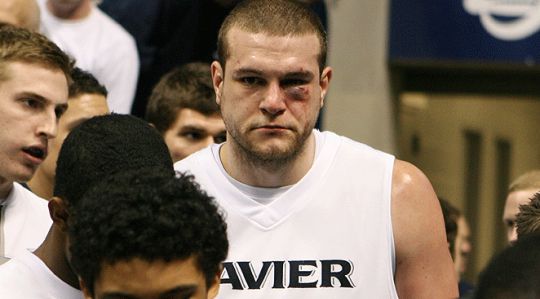
Officials changed the name of the Xavier-Cincinnati cross-town classic in an attempt to disassociate the game from the ugly brawl last season involving Xavier’s Kenny Frease and others (Icon SMI)
There is more than one game being played on the floor of the U.S. Bank Arena, however, as the fate of the Big East looms large in the plans for both schools. Week-long rumors that the Catholic 7 intends to dissolve the conference and reconstitute a basketball-first entity (with the NCAA distributions, the exit fees and the rights to Madison Square Garden for the conference tournament as potential endowments), Cincinnati has to wonder where it will play ball (foot- and basket-) in those athletic facilities it has raised millions of dollars to renovate. Xavier on the other hand, appears to top the list of schools the Catholic 7 intends to invite into the reconstituted conference to bring the membership to 10 or 12.
Read the rest of this entry »
| checking in on, microsites, other 26
| Tagged: alan major, brad stevens, butler, c.j. aiken, carl jones, cashmire wright, Cedrick Lindsay, charlotte, chase stigall, chris braswell, cory remekun, dan hurley, dayton, dee davis, demitrius congers, derek kellogg, duquesne, Dwayne Evans, george washington, jim crews, john giannini, khalif wyatt, la salle, Langston Galloway, lasan kromah, massachusetts, michael eric, mike lonergan, ramon galloway, rhode island, richmond, Rob Loe, rotnei clark, saint bonaventure, saint joseph's, saint louis, samanj christon, scootie randall, sean kirkpatrick, semanj christon, shaka smart, temple, terrence williams, vcu, vee sanford, xavier, xavier mumford
Share this story






























